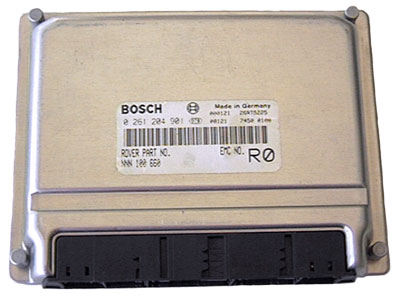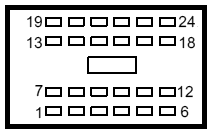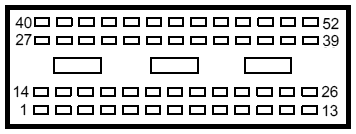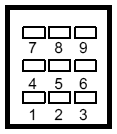Values, configuration settings, and other stored information which can be read from the ECU. Read settings can also be stored as a standard HTML page for reference. These pages can then later be re loaded.
PROGRAMMABLE OPTIONS (DETAILS)
- Part number: This number is calculated from the internally stored Bosch Hardware number.
- Bosch software: This is an internal number which denotes the base software of the ECU. In conjunction with other codes, this helps trace any production problems back to the exact source so that they can be quickly rectified. This code is, therefore, only of use to Bosch in the event of a production / recall problem.
- Supplier no: This is a Bosch code which they use for keeping track of ECUs which may have been constructed by other companies under licence or the code which may have been written to be included in ECUs.
- Production no: This is a unique number for each Motronic ECU which is assigned during production. In essence, it is a Bosch serial number.
- Revision level: This is a number which denotes subtle changes to the base software of the ECU. In conjunction with other codes, this helps trace any production problems back to the exact source so that they can be quickly rectified. This code is, therefore, only of use to Bosch in the event of a production / recall problem.
- Revision Address: This is a Bosch specific code which helps track the source of base software revision modifications. In conjunction with other codes, this helps trace any production problems back to the exact source so that they can be quickly rectified. This code is, therefore, only of use to Bosch in the event of a production / recall problem.
- Plant ID: This is a manufacturer's code which allows tracing to a particular manufacturing facility. In conjunction with other codes, this helps trace any production problems back to the exact source so that they can be quickly rectified. This code is, therefore, only of use to Bosch in the event of a production / recall problem.
- Plant address: This is a manufacturer's code which allows tracing to a particular manufacturing facility. In conjunction with other codes, this helps trace any production problems back to the exact source so that they can be quickly rectified. This code is, therefore, only of use to Bosch in the event of a production / recall problem.
- Diagnostic index: This code is reserved for denoting any minor revisions to the Diagnostic section of the internal software.
- ISN address: This is a code which denotes the actual programming machine which was used to program the base software into this ECU. In conjunction with other codes, this helps trace any production problems back to the exact source so that they can be quickly rectified. This code is, therefore, only of use to Bosch in the event of a production / recall problem.
- BUS index: An unknown internal code for Bosch use only.
- Product week: The week of the year in which this Motronic ECU was manufactured.
- Product year: The year in which this Motronic ECU was manufactured.
- Coding index: This number is reserved to denote any minor revisions to the core coding of the Motronic ECUs.
- Immobilisation Code: This number is the number which the Motronic ECU requires to be sent by the BECM to mobilize. This code will require programming into the BECM settings Immobilisation Code box.
- Bosch hardware code: This number is reserved to denote any minor revisions to the actual electronic hardware of this ECU series.
- Software code: This code denotes the revision level of the vehicle specific code section of the ECU.
- Part no: This is a Bosch part number for this Motronic ECU. This number is for the ECU as a whole and provides for the including of any later uploaded changes. It is, therefore, possible this number may change during the life of the ECU.
- Modification code: This code is used to indicate any late modifications which may have been made to the vehicle specific software, as denoted by the Software Code.
HISTORY INFORMATION RECORD 1-14
The ECU can be programmed (reprogrammed) only 14 times. Each time the settings are stored in a record (1-14) and cannot be overwritten).
- Vehicle identity number: This is the Vehicle Identity Number (VIN).
- Date of programming: This is the date when this record was created.
- ECU assembly no: The assembly is defined as a combination of the ECU's hardware, the engine specific software and the vehicle model / market tune software.
- Emission homologation status: This is a number which correlates to the passing of emission legislation requirements of this ECU assembly.
- Odometer value at program date: When re-programming is done which creates a record, it is possible for the programming tool to use this value to record the odometer value of the vehicle to which this ECU was fitted in kilometres. This number could be entered manually, or the equipment could automatically obtain the value by reading the figure electronically from the relevant Body Control Module. Its value is only of some use as the ECU may be moved between vehicles.
- AIF status: This code, whilst contained in all records, is currently not used for any purpose. It is actually filled with the time of day in hours, minutes and seconds when the re-programming that created this record was performed.
- Programming station: When any re-programming of the Motronic ECU's software for Engine specific code or model / market tune. The programming may be done at a number of stages during the life of the ECU by different programming equipment made by a number. This is a code by which the programming equipment may be recognised. The most common code is T9999; this denotes Land Rovers own TestBook equipment. X codes usually refer to Bosch programming equipment and are often seen in the 1st record which is created during manufacture.
|
 BOSCH MOTRONIC M5.2.1 - System Overview
BOSCH MOTRONIC M5.2.1 - System Overview BOSCH MOTRONIC M5.2.1 - Known Fitments
BOSCH MOTRONIC M5.2.1 - Known Fitments BOSCH MOTRONIC M5.2.1 - Physical Details
BOSCH MOTRONIC M5.2.1 - Physical Details
 BOSCH MOTRONIC M5.2.1 - Pin Outs
BOSCH MOTRONIC M5.2.1 - Pin Outs




